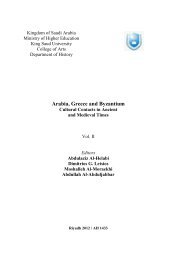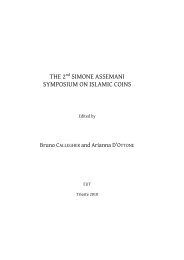ulum-al-quran
ulum-al-quran
ulum-al-quran
Create successful ePaper yourself
Turn your PDF publications into a flip-book with our unique Google optimized e-Paper software.
Begin the Tafsir of the Qur'an with the Qur'an.<br />
Seek guidance from the words and explanations of the Prophet.<br />
Refer to the reports from the sahaba.<br />
Consider the reports from the tabi'un.<br />
Consult the opinions of other eminent scholars.<br />
Grades of Sources [See Ibn Taimiya, op.cit., p.93.]<br />
The best Tafsir is the explanation of the Qur'an by the Qur'an.<br />
The next best is the explanation of the Qur'an by the Prophet Muhammad, who, as Shafi'i explained, acted according to<br />
what he understood from the Qur'an.<br />
If nothing can be found in the Qur'an nor in the sunna of the Prophet, one turns to the reports from the sahaba. [See Ibn<br />
Taimiya, op.cit., p.95.]<br />
If nothing can be found in the Qur'an, the sunna and the reports from the sahaba, one turns to the reports from the<br />
tabi'un. [See Ibn Taimiya, op.cit., p. 102.]<br />
However, nothing can match the explanation of the Qur'an by the Qur'an and the explanation of the Qur'an by the<br />
Prophet.<br />
Kinds of Tafsir<br />
Tafsir may be divided into three basic groups: [This classification has been borrowed from Sabuni, tibyan, p.63. See <strong>al</strong>so<br />
Qattan, op.cit. section 25.]<br />
<br />
<br />
<br />
Tafsir bi-l-riwaya (by transmission), <strong>al</strong>so known as Tafsir bi-l-ma'thur.<br />
Tafsir bi'l-ra'y (by sound opinion; <strong>al</strong>so known as tafsir bi-l-diraya, by knowledge).<br />
Tafsir bi-l-ishara (by indication, from signs).<br />
Tafsir bi-l-riwaya<br />
By this is meant <strong>al</strong>l explanations of the Qur'an which can be traced back through a chain of transmission to a sound<br />
source, i.e.:<br />
<br />
<br />
<br />
The Qur'an itself.<br />
The explanation of the Prophet.<br />
The explanation by Companions of the Prophet (to some extent).<br />
Natur<strong>al</strong>ly, the explanation of the Qur'an by the Qur'an and the explanation of the Qur'an by the Prophet are the two<br />
highest sources for tafsir, which cannot be matched nor superseded by any other source. Next to these rank the<br />
explanations by the sahaba, since the sahaba were witnesses to the revelations, were educated and trained by the<br />
Prophet himself and were closest to the period of the first Muslim umma. Of course <strong>al</strong>l reports of explanations by the<br />
Prophet or by a sahabi must be sound according to the science of riwaya as in '<strong>ulum</strong> <strong>al</strong>-hadith.<br />
The Qur'an explained by the Qur'an<br />
The interpretation of the Qur'an by the Qur'an is the highest source of tafsir. Many of the questions which may arise out<br />
of a certain passage of the Qur'an have their explanation in other parts of the very same book, and often there is no need<br />
to turn to any sources other than the word of Allah, which in itself contains tafsir. To seek to explain an aya from the<br />
Qur'an by referring to another aya from the Qur'an is the first and foremost duty of the mufassir. Only if this does not<br />
suffice, he will refer to other sources of tafsir. [Itqan, 11, pp.181-2.]





